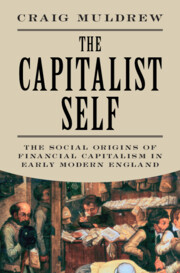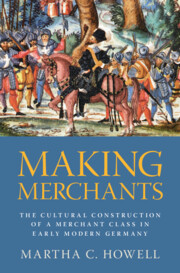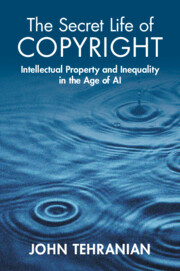Refine search
Actions for selected content:
312 results
8 - Food Hierarchies
-
-
- Book:
- Hunger Redraws the Map
- Published online:
- 01 November 2025
- Print publication:
- 20 November 2025, pp 231-258
-
- Chapter
- Export citation
2 - Theorising the State and Transitions
-
- Book:
- States of Transition
- Published online:
- 31 October 2025
- Print publication:
- 13 November 2025, pp 25-58
-
- Chapter
- Export citation
Chapter 1 - The Bloomsbury Friction
- from Introduction
-
-
- Book:
- A History of the Bloomsbury Group
- Published online:
- 09 October 2025
- Print publication:
- 23 October 2025, pp 3-16
-
- Chapter
- Export citation
6 - Democratic Intimacies: Jokes, Sex, and Ta’arof
-
- Book:
- Tied Up in Tehran
- Published online:
- 28 September 2025
- Print publication:
- 16 October 2025, pp 111-141
-
- Chapter
- Export citation

The Capitalist Self
- The Social Origins of Financial Capitalism in Early Modern England
-
- Published online:
- 12 October 2025
- Print publication:
- 30 October 2025
Introduction
-
- Book:
- Making Merchants
- Published online:
- 19 September 2025
- Print publication:
- 09 October 2025, pp 1-6
-
- Chapter
- Export citation
12 - Capitalism and Class
- from Part III - Merchants in the Round
-
- Book:
- Making Merchants
- Published online:
- 19 September 2025
- Print publication:
- 09 October 2025, pp 186-209
-
- Chapter
- Export citation
Chapter 9 - The Legal Character of Paupers in Early Nineteenth-Century England
-
-
- Book:
- British Law and Literature in the Long Eighteenth Century
- Published online:
- 19 September 2025
- Print publication:
- 09 October 2025, pp 187-208
-
- Chapter
- Export citation
2 - Class Matters: The Sociology of the Profession
-
- Book:
- Palestinian Doctors
- Published online:
- 12 September 2025
- Print publication:
- 02 October 2025, pp 36-70
-
- Chapter
- Export citation
Chosen (not) to win? Party nomination strategies and the unequal class representation in parliament
-
- Journal:
- European Journal of Political Research ,
- Published online by Cambridge University Press:
- 30 September 2025, pp. 1-21
-
- Article
-
- You have access
- Open access
- HTML
- Export citation

Making Merchants
- The Cultural Construction of a Merchant Class in Early Modern Germany
-
- Published online:
- 19 September 2025
- Print publication:
- 09 October 2025
Chapter 2 - The Politics of Impossibilism: Germinal
-
- Book:
- Zola's Dream
- Published online:
- 07 August 2025
- Print publication:
- 21 August 2025, pp 70-121
-
- Chapter
- Export citation
Introduction
-
- Book:
- The Secret Life of Copyright
- Published online:
- 08 August 2025
- Print publication:
- 14 August 2025, pp 1-23
-
- Chapter
- Export citation

The Secret Life of Copyright
- Intellectual Property and Inequality in the Age of AI
-
- Published online:
- 08 August 2025
- Print publication:
- 14 August 2025
Chapter 5 - John Muir’s Yosemite and the Environmental Politics of Genius
-
- Book:
- Landscapes of Genius and the Transatlantic Origins of Environmentalism
- Published online:
- 18 July 2025
- Print publication:
- 07 August 2025, pp 160-201
-
- Chapter
- Export citation
Chapter 3 - Landscapes of Class and Gender
-
- Book:
- Landscapes of Genius and the Transatlantic Origins of Environmentalism
- Published online:
- 18 July 2025
- Print publication:
- 07 August 2025, pp 87-130
-
- Chapter
- Export citation
13 - The Trouble with Oracy?
- from Part III - Oracy in History and in Theory
-
-
- Book:
- Oracy
- Published online:
- 23 September 2025
- Print publication:
- 31 July 2025, pp 188-200
-
- Chapter
- Export citation
5 - From the Ghetto to the Gallows: Rights, Race, Class, and Drug Crimes in Malaysia
- from Part II - People on Death Row
-
-
- Book:
- Capital Drug Laws in Asia
- Published online:
- 07 August 2025
- Print publication:
- 24 July 2025, pp 111-134
-
- Chapter
- Export citation
The Politics of Small Business Owners
-
- Journal:
- British Journal of Political Science / Volume 55 / 2025
- Published online by Cambridge University Press:
- 18 July 2025, e94
-
- Article
-
- You have access
- Open access
- HTML
- Export citation
Chapter 17 - Imagining and Occupying Wall Street
- from Part II - Histories
-
-
- Book:
- Money and American Literature
- Published online:
- 03 July 2025
- Print publication:
- 17 July 2025, pp 293-310
-
- Chapter
- Export citation
